Mobile CPU Wars: Core 2 Duo vs. Core Duo
by Anand Lal Shimpi on August 3, 2006 9:25 AM EST- Posted in
- CPUs
Application Performance using SYSMark 2004 SE
We'll kick off our look at general application performance with SYSMark 2004 SE as always, and we'll look at the overall score as well as the scores in each of the two suites - Internet Content Creation and Office productivity.
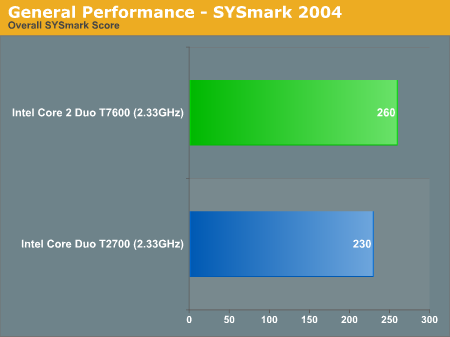
Clock-for-clock, Intel's Core 2 Duo is able to outperform its predecessor by 13% according to SYSMark 2004 SE's overall score. While the performance advantage isn't as dramatic as what we've seen on the desktop, comparing Core 2 to Pentium D, at 13% we're still looking at a performance gain that is noticeable in real world usage.
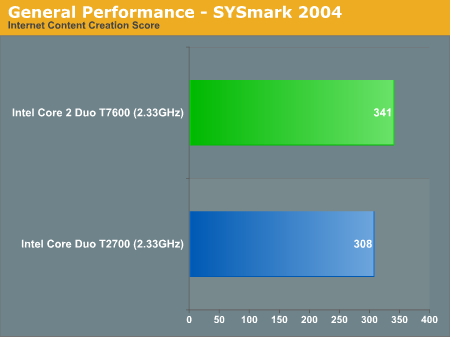
Drilling deeper and looking at the overall Internet Content Creation score, Core 2 Duo's performance advantage drops slightly to 10.7%. The performance increases we're seeing here highlight one very important point in current CPU architecture innovation. We're looking at a 10% increase in performance here, yet it required a 93% increase in transistor count to achieve (mostly because of the larger L2 cache, 4MB vs. 2MB). AMD and Intel are both looking to multi-core solutions to deliver better performance-per-transistor efficiency, rather than simply throwing more clock speed and cache at the problem.
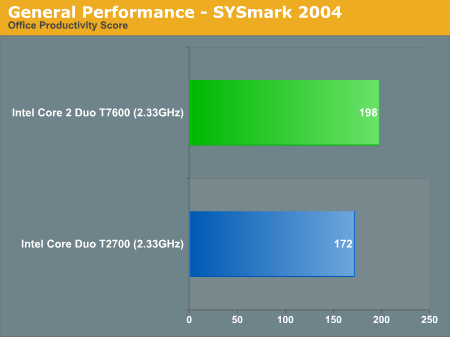
Speaking of the impacts of a larger L2 cache, we may be seeing those here in the Office Productivity suite where Core 2 Duo holds a 15.1% lead over Core Duo. The advantage is large enough to be noticeable, and definitely appreciated when you look at the fact that the Core 2 Duo we're benchmarking here has the same MSRP as its Core Duo predecessor.
The performance increases also come from the modified pipeline and internals, but we will have to get ahold of a 2MB Merom chip to determine exactly how much of the improvement comes from the added cache and how much comes from the reworked architecture.
The breakdown of SYSMark 2004 SE tests are below:


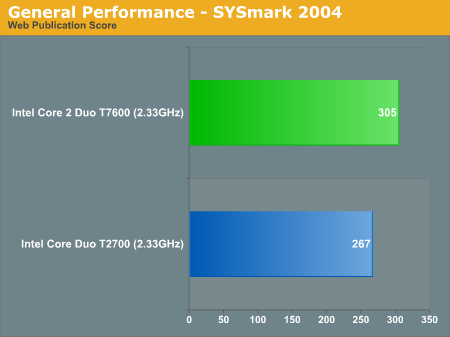

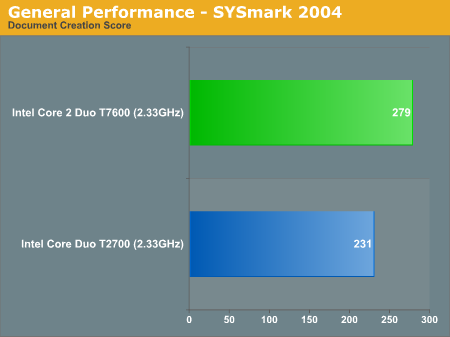











46 Comments
View All Comments
IntelUser2000 - Saturday, August 5, 2006 - link
Correct. Lots of the benchmarks show 10% advantage for Core 2 Duo over Core Duo. The only 10% advantage 4MB L2 over 2MB L2 is in a single app.
bob661 - Thursday, August 3, 2006 - link
Video makes ALL the difference in the world.monsoon - Thursday, August 3, 2006 - link
I'm in the market for a mini PC to do video trancode, and I was considering the MEROM chip to compare to YONAH......in the end, given the right graphic card ( add ATI X1400 series or higher here ) with hardware embedded transcode features, i guess the YONAH fits my bill just right.
And i get to pay 100$ or 200$ less than the same computer with a MEROM which could not offer me better on the video side...
What do you think ?
bob661 - Thursday, August 3, 2006 - link
I would get the best video you can get with the cash saved from getting the Memron.Tiamat - Thursday, August 3, 2006 - link
Whats the difference between the Intel Core Duo T2300E* and the Intel Core Duo T2300E?I see a difference in price, but not specs. The page in the article does not address the asterisk...
Anand Lal Shimpi - Thursday, August 3, 2006 - link
The asterisk means that the CPU lacks support for Intel Virtualization Technology (VT). I had the note on Page 3 but I forgot to include it on Page 2 :) Thanks for the heads up :)Take care,
Anand